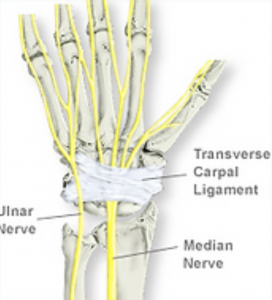Carpal Tunnel
Carpal Tunnel Syndrome is an exceptionally common hand problem where pain and tingling is experienced in the hand because of pressure on the median nerve.
The median nerve enters the hand under the transverse carpal ligament through the carpal tunnel. If there is a build up of pressure in the carpal tunnel the nerve is compressed and can no longer function.

Causes of Carpal Tunnel Syndrome
Carpal Tunnel Syndrome is also related to some other conditions such as: rheumatoid arthritis, diabetes, thyroid disease and pregnancy. Wrist injuries can also be a cause.
Symptoms of Carpal Tunnel Syndrome
Symptoms of Carpal Tunnel Syndrome include:
- pins and needles in the thumb, index and middle fingers
- pain that is worse at night that wakes a patient from sleep
- muscle wasting of the hand
- weakness
- clumsiness
Diagnosis of Carpal Tunnel Syndrome
A diagnosis of Carpal Tunnel Syndrome can be made based on your symptoms and a physical examination. Some tests may be organised included nerve conduction studies to assess the severity of the Carpal Tunnel Syndrome.
Treatment of Carpal Tunnel Syndrome
Underlying medical conditions that may have brought on the Carpal Tunnel Syndrome should be treated.
Non-surgical measures include wrist splinting, anti-inflammatory medications and injections, ice packs, resting and avoiding activities that aggravate the condition.
If the Carpal Tunnel Syndrome is still giving patients significant symptoms then surgery called Carpal Tunnel Decompression may be recommended to relieve the pressure on the nerve. This is a short operation performed under local anaesthesia with a tourniquet around the arm. The tourniquet feels tight like a blood pressure cuff and helps to limit the blood flow to the hand for a short time so the operation can be carried out safely. The local anaesthetic injection can be uncomfortable but numbs the area after a few minutes so the surgery itself is painless.
After Carpal Tunnel Decompression Surgery
A bandage will be wrapped around the wrist but this can be taken off after a couple of days. There will be a small scar over the palm and stitches that will need to be removed after two weeks. Driving is allowed once finger movements are restored (1-2 weeks).
Surrey Orthopaedic Clinic Wrist Specialist:






